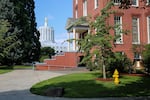On a recent sunny morning, Willamette University president Steve Thorsett sat in his office on the top-floor of Waller Hall, a 152 year-old campus building. Perfectly framed through a tall picture window behind him stood the Oregon Capitol.
Thorsett noted that the school's administration building is older than the Capitol, just as Willamette University predates the state of Oregon.
“We were here first," Thorsett said. "When they built the Capitol, they lined up the dome of the Capitol with the dome of Waller Hall.”

The Oregon Capitol sits just beyond Waller Hall on the campus of Willamette University in Salem, Ore., Wednesday, Aug. 7, 2019. The small private college was founded in 1842.
Rob Manning / OPB
But as Oregon’s population grew by 360,000 people over the last decade, Willamette has gotten smaller. Enrollment during the last school year was the lowest in more than a decade.
National Forces Mean Bad News
The primary drivers behind enrollment declines are big, national forces beyond the control of a small, liberal arts university, Thorsett said. It's partly demographics; the number of 18- to 24-year-olds in the United States has leveled off after growing for years. That means fewer people in the typical college-going age range at the same time that the cost of college is rising and earnings for middle-class families are stagnating.

Willamette University had a smaller student body in 2018-19 than in any year for more than a decade.
Willamette University, Common Data Sets 2006-2018
National statistics show a steady decline in the number of people attending college over the last eight years. Among private colleges, the downward trend leveled off recently — but only for the largest private universities. Smaller colleges, such as Willamette, have seen their enrollment continue to erode.
Related: Linfield College Faces Division, Debate As Leaders Attempt To Defy Enrollment Trends
The trend is particularly pronounced in Oregon, where overall college enrollment has slid downward in each of the last three years by at least 3%. Only a handful of states show a decline as consistent as that.
But it’s not just fewer students; the product that universities are selling is getting increasingly expensive. National summaries show that the average cost of a college education has grown by 3% to 5% per year over the last several years, outpacing the rate of inflation and the growth of average wages.
“Students are less able to pay for higher education," Thorsett said. "Average family incomes of families that have college-aged students have been stalled for 20 years now. And the cost of higher education continues to go up.”

Willamette University president Steve Thorsett in his Waller Hall office in Salem, Ore., Wednesday, Aug. 8, 2019. Enrollment at the small private school last year was at its lowest point in more than a decade.
Rob Manning / OPB
Private colleges such as Willamette are nonprofits, but there's an aspect of business-like competition to them. They’re trying to sell a product that's rising in cost to fewer customers and they rely heavily on tuition to pay the bills.
“Private higher education, because we have an expensive business model, has been facing a more challenging situation than some of our public counterparts, but they’re issues that all of us have to deal with,” Thorsett said.
But Willamette is not just suffering from national trends. It must contend with regional challenges as well.
California Boom And Bust
Demographics and economics alone can’t explain the kind of enrollment drops Willamette has experienced.
“It’s pretty simple: If we’re not meeting our enrollment targets, we have to say ‘Why is that?'” said Debra Ringold, who has taught at the school's Atkinson Graduate School of Management for the last 25 years.
Thorsett acknowledges an open secret at Oregon's oldest college: "The basic story at Willamette is the story of California students."

A sign marks the entrance to Willamette University in Salem, Ore., Wednesday, Aug. 7, 2019. California students used to bolster the student body at the school.
Rob Manning / OPB
A decade ago, nearly half of incoming freshmen at Willamette came from the Golden State. Willamette’s entrance requirements lined up well with students who might otherwise attend University of California schools, and the school's enrollment peaked at 3,076 students, including 2,384 undergraduates, in the 2015-16 school year.
But when California leaders shifted policies in 2015 so that the massive University of California system would enroll more in-state students, Willamette felt the impact almost immediately. Undergraduate enrollment fell by more than 400 students.
Fewer students led to cuts: Willamette’s workforce shrank by 8% from 2014 to 2016, leaving the school with 200 fewer employees. Faculty have noticed some changes, including restructuring of senior capstone requirements, rearrangement of elective courses and larger classes, all aimed at allowing the school to operate with fewer teachers. Professors said the university has avoided layoffs but has also left positions open after staff leave or retire.
"The primary way the College of Liberal Arts has managed enrollment-related budget cuts is through not replacing faculty lines after faculty have retired," said Laura Taylor, faculty representative to the University Council and former faculty chair of a budget advisory council at Willamette.

People gather outside the Mark O. Hatfield Library on the campus of Willamette University in Salem, Ore., Saturday, April 27, 2019. Lower enrollment in recent years has led to other cuts.
Bradley W. Parks / OPB
Staff members said Willamette has put a lot of effort into maintaining academic quality and services for students through the recent lean years. Expanding to meet growing needs is another story.
"We have not been able to expand some student services as much as we would have liked in order to accommodate increasing demand for them," said Nathan Sivers Boyce, an associate professor on Willamette's economics faculty.
"This seems particularly true in health care, especially mental health services, and career services. We have great people doing really good work in both areas, but we would like to expand those even more."
Finding A Path Forward
As Taylor and Boyce suggest, part of Willamette's approach to falling enrollment, and the related tighter budgets, has been to do more with less.
Ringold, for example, has taught graduate students at Willamette for 25 years. This fall, she’s also teaching undergrads. She likes it.
"What’s exciting about it for me is that you’re getting cross-fertilization across the three colleges or schools, and the sum of the parts is greater than the whole," she said.

The Willamette University campus in Salem, Ore., Wednesday, Aug. 7, 2019. Faculty and staff are searching for the road ahead for the American West's oldest university.
Rob Manning / OPB
University leaders said that in recent years, Willamette has been helped by having multiple colleges — the liberal arts college for undergraduates, the law school and the management graduate school. Provost Carol Long said the university can be more resilient if one part of the university loses enrollment, because other parts can grow.
"Right now the [business program] is having some challenges in enrollment, but the college of law is doing better," Long said. "As long as they don't all go down at the same time, we're good."
Now, rather than looking to California only as a place to recruit students, university leaders are finalizing plans to bring an entire institution north.
Related: Oregon Colleges Forced To Adjust As Student Priorities Expand
After two years of talks, Willamette has finalized acquisition of the Claremont School of Theology, a small college based in Claremont, California, starting out as a 120-student, "hybrid (online, low-residency)" program, as described by theology school officials. It means a new course of study at Willamette and allows what's been a 350-student theology school to take advantage of the resources of a far larger university. And by incorporating a theology school, Willamette is signaling its ongoing investment in social science and humanities — the liberal arts, in other words — at a time when tight finances are putting pressure on colleges and universities to cut.
Willamette is also investing in Oregon students. The university announced recently that it's the first college in Oregon to participate in a partnership with the state treasurer to match family savings, dollar-for-dollar.
But if families from California want to take advantage of the savings match, they'll have to plan way ahead. The way Willamette structured the program, a student needs at least four years of savings to be eligible for a match.

